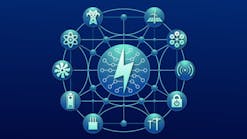It’s vacation time for me and I’m sitting here with my wife, Pam, at 37,000 ft, cruising along at 500 mph. We’re heading off to visit the oldest fortified city in North America, Vieux-Québec, which dates back to 1608. Having grown up near St. Augustine (1565) and living down the road from Santa Fe (1610), gives places like this a special meaning to me. I should be thinking about quaint stone buildings, narrow streets, great food — anything other than writing this editorial, but I can’t.
One of my favorite topics, digital technology, is nagging me and it’s nagging me big time. Digital technology has been the focus of the "Charging Ahead" segment since I started writing it. Experts and colleagues alike have been telling me it is changing everything about our daily lives, and it is really staring me right in the face sitting in this new Boeing 737-800 (not the Max-8). I don’t mean the electronics and avionics in the cockpit; that’s a given. It’s the passengers that have gotten my rapt attention.
They are all carrying e-readers, laptops, tablets, smartphones, and so forth, but the big attention getter is the fact the airplane is ready for them. There are a couple of power outlets at my seat along with USB connections. High speed Wi-Fi is available at 37,000 ft, which kind of gives a new meaning to "cloud computing," but I’m getting ahead of myself. We hadn’t left the gate when the cabin crew told us to download the airline’s in-flight app before they closed the door.
It would provide free gate-to-gate internet, music, movies, messaging, and video streaming. In other words, the airline’s in-flight app gave our tech toys the connectivity we have come to expect in our homes and offices. That is when I noticed there was not a screen in the seatback in front of me. As I looked around, there weren’t any of the ubiquitous seatback screens anywhere to be seen in the cabin. Interestingly, the airlines are taking advantage of their customer’s connectivity.
Hopping on the internet, I did a little research and found out there are several reasons the airlines are ditching seatback screens and embracing passenger’s personal devices. First of all, it can cost an airline up to US$10,000 per seat for all the entertainment electronics and with a couple of hundred seats per plane it adds up across the fleet. Secondly, removing the electronics reduces the weight of each of the aircraft, which in turn reduces fleet fuel consumption — more savings.
There is also the fact that passengers favor their own personal devices (more state-of-the-art), which allows the removal of the under-seat floor mounted electronics box, giving passengers more leg room — customer satisfaction. Hmm…reducing operating costs and improving customer satisfaction, see why I was fixated on technology? These are two of the same major benefits we hear all the time about smart grid technology offering the power delivery systems. Ever since advanced metering infrastructure (AMI) was introduced to the grid, the industry has been working on making the customer a partner in energy savings, load management, distributed energy resources (DERs), and other systems.
According to the U.S. Energy Information Administration (EIA), about half of all U.S. electric customers have smart meters. EIA reports, "AMI data provides utilities with detailed outage information in the event of a storm or other system disruption, helping utilities restore service to customers more quickly and reducing the overall length of electric system outages," but that is only the tip of the iceberg.
Add in the customers’ internet of things (IoT) devices such as intelligent thermostats, security systems, smart appliances, solar panels with battery packs, and all the other electronics popping up, it’s having an impact on both sides of the meter. It even has a name — meter data management (MDM). MDM systems are basically data storage systems for long term use.
Systems have been developed using this data to forecast loads at the customer level, and there are third parties offering a service known as head end system (HES), which is simply a collection system. Where it is getting interesting is adding in artificial intelligence for data interpretation; now the customers’ electronics are helping to identify potential strains on the grid. I think we will be talking about this a lot more in the future. Whether the business is moving people or electricity from point "A" to point "B," it seems digital technologies are changing business plans.


